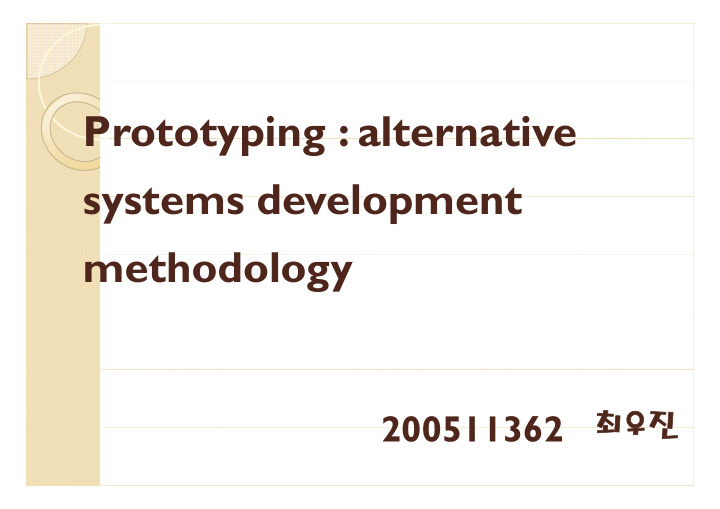



Prototyping : alternative Prototyping : alternative systems development systems development methodology h d l 200511362 최우진 200511362 최우진
목 차 차 � CONSENSUS DEFINITION CONSENSUS DEFINITION � RATIONALE FOR PROTOTYPING RATIONALE FOR PROTOTYPING � ADVANTAGES OF PROTOTYPING ADVANTAGES OF PROTOTYPING � DISADVANTAGES OF PROTOTYPING DISADVANTAGES OF PROTOTYPING � PROTOTYPING FORM PROTOTYPING FORM � DETERMINATION OF WHEN TO PROTOTYPE DETERMINATION OF WHEN TO PROTOTYPE DETERMINATION OF WHEN TO PROTOTYPE DETERMINATION OF WHEN TO PROTOTYPE � SUMMARY � SUMMARY SUMMARY SUMMARY P. 2
CONSENSUS DEFINITION CONSENSUS DEFINITION � Prototyping � Prototyping ◦ 소프트웨어 시스템이나 컴퓨터 하드웨어 시스템을 본격적으로 생산하기 전에 그 타당성의 검증이나 성능 평가를 위해 미리 시제품(prototype)을 만들어 보는 모형제작방법 만들어 보는 모형제작방법 P. 3
CONSENSUS DEFINITION CONSENSUS DEFINITION P. 4
RATIONALE FOR PROTOTYPING(1/3) RATIONALE FOR PROTOTYPING(1/3) • User seldom have clear, concise understanding of their informational needs. Therefore, they , y cannot prespecify the requirements. • The larger the development team, including The larger the development team, including user representatives, the more difficult communication becomes communication becomes. P. 5
RATIONALE FOR PROTOTYPING(2/3) RATIONALE FOR PROTOTYPING(2/3) � Systems being developed today are more � Systems being developed today are more complex, have a larger mission, and require many months to complete. th t l t • The traditonal approach has not served to The traditonal approach has not served to shorten delivery time, in fact it may unduly lengthen the time required due to the lengthen the time required due to the emphasis on documentation. P. 6
RATIONALE FOR PROTOTYPING(3/3) RATIONALE FOR PROTOTYPING(3/3) � Most large companies have a long backlog of g p g g projects awaiting initiation, while the users who requested them are fustrated who requested them are fustrated, disillusioned, and ready to revolt. � All of these problems suggest that some revolutionary technique is needed. revolutionary technique is needed. • Prototyping is one technique that attempts Prototyping is one technique that attempts to address these problems and provide possible solutions possible solutions. P. 7
ADVANTAGES OF PROTOTYPING(1/3) ADVANTAGES OF PROTOTYPING(1/3) • Systems can be developed much faster. Systems can be developed much faster. • Systems are easier for end-users to learn S i f d l and use. • Programming and analysis effort is much Programming and analysis effort is much less (less humanpower needed) • Development backlogs can be decreased Development backlogs can be decreased. P. 8
ADVANTAGES OF PROTOTYPING(2/3) ADVANTAGES OF PROTOTYPING(2/3) � Prototyping facilitates end-user involvement. Prototyping facilitates end user involvement. • System implementation is easier because users • System implementation is easier because users know what to expect. • Prototyping enhances user/analyst • Prototyping enhances user/analyst communication. • User requirements are easier to determine. User requirements are easier to determine. P. 9
ADVANTAGES OF PROTOTYPING(3/3) ADVANTAGES OF PROTOTYPING(3/3) • Development costs are reduced. D l d d • The resultant system is the ‘right’ system and needs little changing needs little changing • Divide a software function and develop will be able to arrive with point evidence and to last bl t i ith i t id d t l t software. P. 10
DISADVANTAGES OF PROTOTYPING(1/2) DISADVANTAGES OF PROTOTYPING(1/2) � Undue user expectations. Und e ser e pectations • Inconsistencies between prototype and final system system. • Encouragement of end-user computing • Final system inefficiencies Final system inefficiencies P. 11
DISADVANTAGES OF PROTOTYPING(2/2) DISADVANTAGES OF PROTOTYPING(2/2) � Lack of attention to good human factors. • Inattention to proper analysis • When from prototype developing with the end • When from prototype developing with the end item, the many change will be able to occur. P. 12
PROTOTYPING PROTOTYPING FORM FORM � The iterative approach (Type 1) P. 13
PROTOTYPING FORM � The throwaway approach (Type 2) yp P. 14
ITERATIVE VERSUS THROWAWAY PROTOTYPING ITERATIVE VERSUS THROWAWAY PROTOTYPING � The iterative approach(Type1) uses the � The iterative approach(Type1) uses the prototype as the final system after a series of evolutionary changes based on user feedback. l ti h b d f db k • The throwaway approach uses the prototype built in a 4GL as a model for the final system built in a 4GL as a model for the final system, with the final system coded in a 3GL. P. 15
DETERMINATION DETERMINATION OF OF WHEN WHEN TO TO PROTOTYPE PROTOTYPE � Determination of whether to use the iterative � Determination of whether to use the iterative prototyping technique, which will evolve into the final system, or the throwaway type, which th fi l t th th t hi h may be used primarily to model the user interfaces, however, is dependent on several variables. P. 16
DETERMINATION DETERMINATION OF OF WHEN WHEN TO TO PROTOTYPE PROTOTYPE • Is dynamic(always • Is stable changing)? • Is large and complex • Is large and complex • Is transaction- • Is decision-support processing based? processing based? based • Contain extensive user Contain extensive user • Is of no predictable • Is of no predictable dialogues? form • Is well defined? • Does extensive number crunching P. 17
S U M M A R Y ( 1 / 2 ) � Prototyping is the process of quickly building a � Prototyping is the process of quickly building a model of the final software system, which is used primarily as a communication tool to d i il i ti t l t assess and meet the information needs of the user. P. 18
S U M M A R Y ( 2 / 2 ) • Systems built with the use of prototyping can • Systems built with the use of prototyping can be highly successful if a strict methodology is adhered to and thorough analysis and dh d t d th h l i d requirements definition takes place before prototyping is attempted P. 19
-끝- 끝 P. 20
Recommend
More recommend